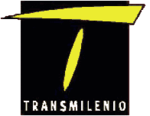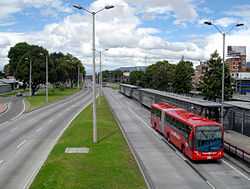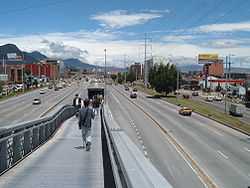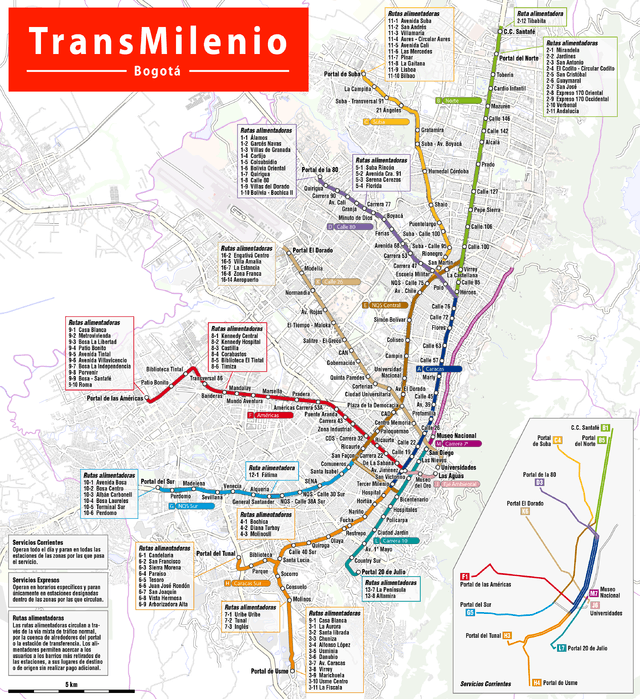TransMilenio
| TransMilenio | |
|---|---|
 | |
| Background | |
| Locale | Bogotá, Colombia |
| Transit type | bus rapid transit |
| Number of lines | 12[1] |
| Number of stations | 136 (17 under construction) |
| Daily ridership | 2,2 million |
| Operation | |
| Began operation | December 2000 |
| Operator(s) | TransMilenio S.A. |
| Technical | |
| System length | 87 km (54 mi)[2] |
TransMilenio is a bus rapid transit system that serves Bogotá, the capital of Colombia. The system opened to the public in December 2000, covering Av. Caracas and Calle 80. Other lines have been added gradually over the next several years, and as of 2012, 12 lines totalling 112 km (70 mi)[2] run throughout the city becoming the world's largest system of bus rapid transit




Inspired by Curitiba's Rede Integrada de Transporte (Integrated Transportation Network), TransMilenio consists of several interconnecting BRT lines, each composed of numerous elevated stations in the center of a main avenue, or "troncal". Passengers typically reach the stations via a bridge over the street. Usually, four lanes down the center of the street are dedicated to bus traffic. There are both express and local buses, the latter stopping in every station to pick up passengers. The outer lanes allow express buses to bypass buses stopped at a station.
Users pay at the station entrance via a smart card, pass through a turnstile, and await the arrival of the bus inside the station, which is typically 5 m wide.[3] The bus and station doors open simultaneously, and passengers board by simply walking across the threshold. Like a subway system, the elevated station platform and the bus floor are at the same height.
The buses are diesel-powered, purchased from such manufacturers as the Colombian-Brazilian company Marcopolo-Superior, German conglomerate Mercedes-Benz, and Scandinavian based companies as Volvo and Scania. The buses are articulated (split into two sections with an accordion-like rotating middle to allow for sharp turns) and have a capacity of 160 passengers. In May 2007, a new, larger bus, with capacity for 270 passengers, was presented to the public. This bus has three sections with two articulations and will be used in phase III. TransMilenio buses are not equipped with transponders to give them traffic signal priority, a regret voiced by the general manager of the system, Angelica Castro.[3]
As of October 2012, up to 1,400 buses were circulating on the troncal system[2] and the fare is 1700 Colombian pesos for a single trip (about EUR 0.75 or USD 0.9, as of October 2012). Cards use a contactless smart card (MIFARE) system, and multiple trips may be purchased for one card. Most users are distrustful, and only purchase one or two trips at a time due to problems with the cards at the launch of the system.[citation needed] Although the technical problems have been fixed, there are no financial incentives (discounts) for multiple purchases or public education campaigns (despite what urban planning consultants recommended).
An additional set of 410 regular buses, known as "feeders" (alimentadores, in Spanish), transport users from certain important stations to many different locations that the main route does not reach. Unlike the main TransMilenio buses, feeders operate without dedicated lanes, are not articulated and are green (regular TransMilenio buses are red). There is no additional fare to use the feeder buses.
Bogotá has many bicycle paths built throughout the city in conjunction with TransMilenio. Five percent of trips in Bogotá today are by bicycle. TransMilenio stations at each end of a line have huge bicycle parking facilities to facilitate bicyclists using the system.
Costs, ridership, and impact
According to a United States Transportation Research Board (TRB) case study report, the construction cost for the first phase of $8 million per mile (41 km was US$240 million, or US$5.9 million/km). The system is overseen by a public body, which awards contracts to private bus companies on a competitive basis. According to TRB, private contractors are paid based upon the total number of kilometers that their vehicles operate..[4]
Daily ridership quickly reached 800,000 after the system opened. TransMilenio has since been expanded and ridership in early 2006 was 1,050,000 daily, and in 2009 was 1,400,000 daily. Seventy-five percent of Bogotans rate the system as good or very good.[5]
Eventually, there is a plan to build 388 km of route, which will provide a very dense network of rapid transit for an urban area with an estimated land area of approximately 500 km2. For example, Madrid covers nearly as much land area and has one of the most dense Metro systems in the world, with approximately 230 km of route. TRB reports that the 388 km system is projected to cost $3.3 billion, only 10% more than a previously proposed Metro of 30 km would have cost.
Most Bogotans have found Transmilenio to be an improvement over previous bus service. An independent survey in 2005 reported that a majority of respondents thought the new bus system superior, and only 15% thought it worse. Transmilenio was also found faster and more convenient than other competing transport choices. When asked about problems, many survey takers complained about overcrowded buses. Between 20 and 30% cited pickpockets and long wait times as problems.[6]
As in any other highly crowded area, users of TransMilenio must be aware that when riding the system they are exposed to pickpockets. Isolated instances of people getting mugged have been reported as well. Security on buses and in stations is handled by police officers employed by the city. However, most of the time the officers assigned are recently graduated high school students serving their mandatory year with the armed forces ('Policía Bachiller'). Higher-ranking officers are assigned as supervisors and respond when a Policía Bachiller requests assistance.
The price of the ticket is 1750 Colombian pesos (approximately US $0.85) which is more expensive than a ticket of a metro system like Buenos Aires. This has not prevented the buses from being congested even during non-peak times.
Routes and stations
TransMilenio has 12 lines serving 150 stations in the city of Bogotá:
 Caracas between Calle 76 and Tercer Milenio: 14 stations
Caracas between Calle 76 and Tercer Milenio: 14 stations Autonorte between Centro Comercial Santafé and Héroes: 16 stations
Autonorte between Centro Comercial Santafé and Héroes: 16 stations Suba between Portal de Suba and San Martín: 14 stations
Suba between Portal de Suba and San Martín: 14 stations Calle 80 between Portal de la 80 and Polo: 14 stations
Calle 80 between Portal de la 80 and Polo: 14 stations NQS Central between La Castellana and Ricaurte: 11 stations
NQS Central between La Castellana and Ricaurte: 11 stations Américas between Portal de Las Américas and Avenida Jiménez: 18 stations (including Ricaurte station)
Américas between Portal de Las Américas and Avenida Jiménez: 18 stations (including Ricaurte station) NQS Sur between Comuneros and Portal del Sur: 12 stations
NQS Sur between Comuneros and Portal del Sur: 12 stations Caracas Sur between Hospital and Portal de Usme and Portal del Tunal: 16 stations
Caracas Sur between Hospital and Portal de Usme and Portal del Tunal: 16 stations Eje Ambiental between Museo del Oro and Universidades: 3 stations
Eje Ambiental between Museo del Oro and Universidades: 3 stations-
 Calle 26, between Portal Eldorado and Centro Memoria: 13 stations.
Calle 26, between Portal Eldorado and Centro Memoria: 13 stations.  Carrera Décima between Portal 20 de Julio and San Diego: 10 stations.
Carrera Décima between Portal 20 de Julio and San Diego: 10 stations. Carrera Séptima: Museo Nacional: 1 station.
Carrera Séptima: Museo Nacional: 1 station.

Since the May 2006 expansion, the TransMilenio Route System changed dramatically, with new sections added to the system. Instead of being numbered, routes have a combination of letters and numbers. In order to fill the information gap, TransMilenio made available an interactive guide that includes routes, stations, nearby places and routes combination.[7]
New lines are being constructed including one in Calle 26 (Downtown-West (Airport)) and the other in Carrera 10 (Downtown-South). They should become operational in the second semester of 2012.[8]
It is under consideration to start constructing a new line in Carrera 7 (North-Downtown), which has been criticized as there are certain parts in which the system might not fit.
There are five types of stations:
- Sencillas (Simple): local service stations, located approximately every 500 m.
- De transferencia (Transfer): allow transfer between different lines through a tunnel.
- Sin intercambio (No transfer): do not allow transfer from the north-south line to the south-north line; located in a stretch of the Autopista Norte
- Intermedias (Intermediate): service both feeder and trunk lines.
- Cabecera (Portal): near the entrances to the city. In addition to feeders and articulated buses, intercity buses from the metropolitan area also arrive at these stations.
All stations have electronic boards announcing the approximate arrival time of the next bus. Wait times are short as there is usually a bus serving the station. There are also station attendants to provide assistance to the passengers, and posted system maps.
History
Before TransMilenio, Bogotá's mass transit "system" consisted of thousands of independently operated and uncoordinated mini buses. There was also a plan on the table for a network of elevated highways throughout Bogota, costed at 'multi-billion dollars'. The Enrique Peñalosa was elected mayor he cancelled the project and oversaw the construction of the initial TransMilenio system at a fraction of the cost.[9]
Within three years from initiation of the scheme, the first phase opened in December 2000. A second phase has been completed, and a third is underway. Prior to construction, a 30km trip by public transport would take 2 hours 15 minutes in 1998, the same trip using TransMilenio now takes 55 minutes.[9]
The mayor created a special company to build the project and run the central system. The operational design of TransMilenio was undertaken by transport consultants Steer Davies Gleave with the financial structuring of the project lead by Capitalcorp S.A., a local investment bank. Most of the money required to build TransMilenio was provided by the Colombian central government, while the city of Bogotá provided the remaining 30%.[10]
Other cities are building systems modeled on Transmilenio, for example Mexico City.[11]
TransMilenio stations comply with easy access regulations because they are elevated and have ramps leading to the entrance. The alimentadores (Feeders) are normal buses without handicapped accessibility. A lawsuit by disabled user Daniel Bermúdez caused a ruling that all feeder systems must comply with easy access regulations by 2004, but this has not happened yet.
2006 protests
On May 2 and 3, 2006, several groups of bus drivers not associated with TransMilenio held a strike, protesting against some elements and consequences of the system. They disagreed with the amount of monetary compensation that they would receive in exchange for the disposal of old buses (10 to more than 20 years old), traffic restrictions on the TransMilenio main lines, and a new Pico y Placa Ambiental in some city areas, that would restrict the schedules of buses older than 10 years to early morning hours to reduce pollution in the city.
Some of the larger bus companies, which participate in TransMilenio, also retired their conventional bus lines during the strike. Public transportation ground to a halt in much of the city, though TransMilenio and a number of other buses continued operating they could not cope with all of the demand. Acts of individual intimidation and violence against some private vehicles, TransMilenio and conventional buses occurred during the strike, as well as clashes between some of the strikers and the police.
Bogotá's Mayor Luis Eduardo Garzón rejected the strike, firmly defended all of the measures as necessary for the city's transportation future, and stated that he was only willing to discuss the specific details of their implementation, as well as a further democratization of TransMilenio's operations, after the situation calmed down. During the second and final day of the strike, the local administration, the strikers and their companies agreed to begin talks.
During the strike, some protests included users of TransMilenio who complained because the buses were passing at a very low frequency. Several stations became so filled up that some people fell from them into the street. Even after the strike ended, some TransMilenio passengers have subsequently protested because they still find different aspects of the system to be inefficient and uncomfortable.
2012 protests
Due to the relatively high price ($1) and overcrowding, students protested and some vandals looted and broke windows on March 9, 2012 causing half-a-million dollars damage and 11 injuries.[12]
Legal framework
With more than 10 years of experience, the Transmilenio bus-based rapid transit system is a public-private partnership that has a solid legal framework and good practices that have served as examples to other areas of the world. The summaries of the contractual framework are both in English and Spanish. However, the actual contracts are in Spanish and annotated also in Spanish. All of the related documents are on the public domain.[13]
See also
References
- ↑ "TRANSMILENIO S.A. - Servicios Troncales - Servicios por Zona" (in Spanish).
- ↑ 2.0 2.1 2.2 "TRANSMILENIO S.A. - Estadísticas Generales" (in Spanish).
- ↑ 3.0 3.1 "Bogota Transmilenio", Bus Rapid Transit Policy Center (February 2007)
- ↑ TRB Online Case Studies, "TransMilenio BRT", ca. 2001
- ↑ "Why Is TransMilenio Still So Special?", by Dario Hidalgo, TheCityFix.com, August 5, 2008
- ↑ Applicability of Bogotá’s TransMilenio BRT System to the United States, p. ix, by Alasdair Cain, Georges Darido, Michael R. Baltes, Pilar Rodriguez, Johan C. Barrios, National Bus Rapid Transit Institute (2006)
- ↑ "Portal de Rutas TransMilenio Mapa Bogota suRumbo.com". Retrieved 2012-10-11.
- ↑ Diario El Tiempo (5 June 2010). "Le Metieron El ‘Acelerador’ A La 26". Retrieved 5 June 2010.
- ↑ 9.0 9.1 "Bus Rapid Transit: Bogotá". StreetFilms.
- ↑ Roger East. "Bogota's bus rapid transit system and cycle lanes"". Societyguardian.co.uk.
- ↑ William L. Hamilton (2006-01-12). "A Global Look at Urban Planning". New York Times.
- ↑ "Bogota's Vaunted Transit System — Model for Transjakarta — in Distress". March 14, 2012.
- ↑ "PPP in Infrastructure Resource Center". World Bank. October 31, 2012.
External links
| Wikimedia Commons has media related to TransMilenio. |
- Official web site of TransMilenio (Spanish)
- Bogota's New Transit System a TransMilenio slideshow by the New York Times.
- The Economics of TransMilenio an economic analysis of Bogotá's BRT system
- Unofficial map of stations at Google Maps
Coordinates: 4°38′56″N 74°06′31″W / 4.6490°N 74.1086°W